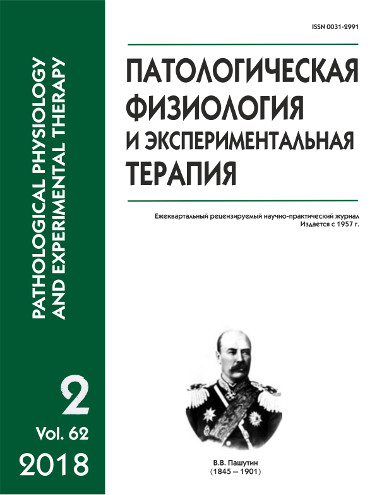Этиопатогенетические механизмы возникновения дезадаптивных расстройств у человека в процессе обучения
Аннотация
Цель исследования. Анализ факторов риска и патогенетических механизмов развития дезадаптивных расстройств (ДР) у человека в процессе обучения. Методика. В работе использованы общенаучные методы теоретического познания: абстрагирование, анализ и синтез, аналогия, индукция и дедукция, мысленное моделирование. Результаты. Показано, что пограничные расстройства адаптации имеют бифункциональную природу и характеризуются бессимптомным течением. Установлена роль социогенных факторов среды в возникновении ДР. Акцентируется, что ДР часто формируются в процессе обучения под воздействием неблагоприятных факторов среды и образа жизни. Рассмотрена роль этиологических факторов риска в развитии ДР, обсуждаются особенности течения психосоматических расстройств у студентов, их психофизиологический статус и особенности проявления у них дезадаптации. Детально анализируются современные представления об организации ДР при различных вариантах приспособления организма человека к условиям учебной среды. Обсуждается влияние типологии на уровень адаптации (дезадаптации) организма и системная организация психических функций. Показано ведущее значение в патогенезе ДР активации лимбико-ретикулярных образований, дисфункции срединно-стволовых структур мозга и дезинтеграции корково-подкорковых взаимоотношений. Заключение. Сделан вывод, что понимание механизмов развития ДР позволяет применять различные методы профилактики ДР. Обсуждаются некоторые немедикоментозные и фармакологические средства коррекции ДР и санаторная реабилитация обучающихся. Установление истинных механизмов развития дезадаптивных расстройств обеспечит решение многих вопросов патофизиологии интегративной деятельности мозга. Это в свою очередь позволит найти пути нормализации психосоматических нарушений, применять более эффективные методы медико-психологической помощи населению.
Скачивания
Литература
2. Александровский Ю.А. Социогенные психические расстройства. Российский психиатрический журнал. 2014; (3): 21-4.
3. Касаткина Н.Э., Семенкова Т.Н. Проблема адаптации студентов вуза к процессам обучения и сохранения здоровья. Вестник Кемеровского государственного университета культуры и искусств. 2012; 1(18): 165-73.
4. Рубченко А.К. Социально-психологические факторы дезадаптации обучающихся. Международный академический вестник. 2014; (2): 22-5.
5. Новоженина В.С. Проблема психической и социально-психологической адаптации у студентов первого курса Южно-Уральского государственного медицинского университета. Вестник Совета молодых ученых и специалистов Челябинской области. 2014; (5): 104-8.
6. Погонышева И.А., Погонышев Д.А., Лукьяненко Ю.Г. Взаимосвязь уровня тревожности и дезадаптации студентов. Вестник Сургутского государственного университета. 2015; 3(9): 65-9.
7. Постнова М.В. Система мероприятий по повышению адаптации к университетской среде. Вестник Волгоградского государственного университета. Серия 11: Естественные науки. 2013; 2(6): 69-78.
8. Будук-оол Л.К., Ховалыг А.М., Сарыг С.К. Особенности социально-психологической адаптации и психоэмоционального статуса студентов-первокурсников некоторых факультетов университета. Вестник Тувинского государственного университета. Естественные и сельскохозяйственные науки. 2015; 2(25): 26-34.
9. Mazurkiewicz R., Korenstein D., Fallar R., Ripp J. The prevalence and correlations of medical student burnout in the pre-clinical years: a cross-sectional study. Psychol Health Med. 2012; 17(2): 188-95.
10. Берестнева О.Г., Уразаев А.М., Шелехов И.Л. Основные этапы индивидуальной адаптации. Современные проблемы науки и образования. 2013; (6): 711-17.
11. Бура Л.В., Чабанюк А.С., Похвалитова О.А. Особенности адаптации студентов первокурсников к обучению в высшем учебном заведении. Проблемы современного педагогического образования. 2016; 50(2): 206-12.
12. Финогенко Е.И. Вегетативные нарушения как критерий дезадаптивных состояний студентов вуза. Вестник Иркутского государственного технического университета. 2015; 4(99): 341-45.
13. Горчакова В.А., Ланда Л.А., Матыцына В.А., Краснова В.В., Клименкова Е.Н., Холмогорова А.Б. Психологическая дезадаптация у студентов системы среднего и высшего профессионального образования: сравнительный анализ. Психологическая наука и образование. 2013; (4): 5-14.
14. Трофимова Н.С. Исследование взаимосвязи социально-психологической адаптации и субъективности личности студента колледжа. Педагогическое обозрение в России. 2013; (3): 116-21.
15. Трофимова Н.С. Характеристика типологии студентов-первокурсников колледжа на этапе социально-психологической адаптации. Теория и практика общественного развития. 2014; (3): 99-103.
16. Шукуров Ф.А. Межличностные отношения и вегетативный статус в оценке адаптационных возможностей студентов. Здоровье, демография, экология финно-угорских народов. 2015; (4): 65-8.
17. Судаков К.В. Системная организация психической деятельности. Психологический журнал. 2013; 34(6): 72-81.
18. Холмогорова А.Б., Климова И.Д. Копинг-стратегии и эмоциональная дезадаптация у студентов с чертами пограничного расстройства личности. Консультативная психология и психотерапия. 2014; 2(81): 153-67.
19. Шифнер Н.А., Бобров А.Е., Кулыгина М.А. Клинические особенности и варианты динамики расстройств адаптации у студентов. Вестник психиатрии и психологии Чувашии. 2012; (8): 43-61.
20. Давыдова Н.С. Психофизиологический мониторинг как метод ранней диагностики школьной дезадаптации. Академический журнал Западной Сибири. 2012; (2): 4-5.
21. Боярская Л.Н., Горбачёва С.В., Потапенко С.В. Значение дефицита магния в формировании вегетативной дезадаптации у детей и подростков с патологией желудочно-кишечного тракта. Запорожский медицинский журнал. 2015; 6(93): 29-32.
22. Окладников В.И. Психодиагностика и психокоррекция в лечении нейросоматических расстройств. Сибирский медицинский журнал (Иркутск). 2014; (8): 120-22.
23. Szabo S., Gyires K. Naming and classification of steroids and human stress ulcers. Articles of historic significance published by Hans Selye 70 years ago. Orv Hetil. 2015; 156(35): 1406-14.
24. Tache Y. Hans selye and the stress response: from "the first mediator" to the identification of the hypothalamic corticotropin-releasing factor. Ideggyogy Sz. 2014; 67(3-4): 95-8.
25. Нотова С.В., Кияева Е.В., Алиджанова И.Э. Психодиагностика дезадаптивных нарушений студентов различных социальных групп. Современные проблемы науки и образования. 2015; (3): 228-33.
26. Смольнякова О.В., Корнеева С.И., Филиппенко Н.Г. К вопросу об эффективности сочетанной коррекции проявлений психологической дезадаптации у лиц 18-22 лет с донозологическими проявлениями вегетативной дисрегуляции. Научные ведомости Белгородского государственного университета. 2012; выпуск 20/3; 22(141): 66-70.
27. Санинский В.И. Возможности библиотерапии в профилактике дезадаптации. Актуальные проблемы экономики и менеджмента. 2014; 1(1): 85-9.
28. Татаринова Г.Ш., Отарова Н.И. Профилактика стрессовых состояний среди студентов. Новая наука: опыт, традиции, инновации. 2016; 5(83): 13-5.
29. Семикин Г.И., Храмелашвили В.В., Кушнарев В.М. Профилактика и коррекция психологической дезадаптации у студентов МГТУ им. Н.Э. Баумана. Живая психология. 2016; 3(2): 145-52.
30. Николаева Е.Н., Колосова О.Н., Яковлева А.П., Мельгуй Н.В. Некоторые психофизиологические особенности здоровья студентов на севере и возможность их коррекции. Вестник Северо-Восточного федерального университета им. М.К. Аммосова. 2012; 9(4): 140-45.
31. Остапенко И.А. Психолого-педагогические аспекты адаптации студентов факультета среднего профессионального образованияв системе вуза. Азимут научных исследований: педагогика и психология. 2016; 2(15): 120-23.













